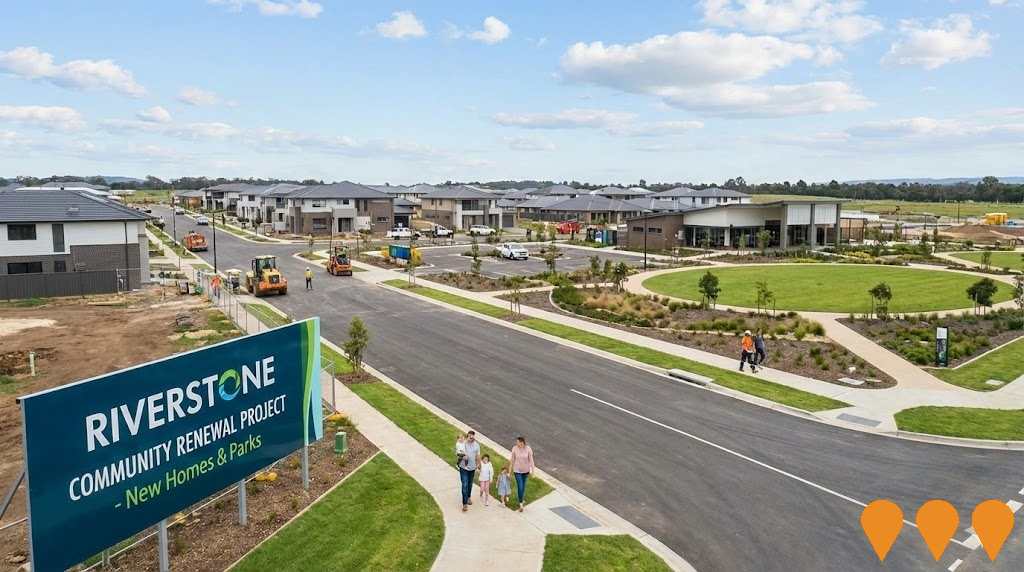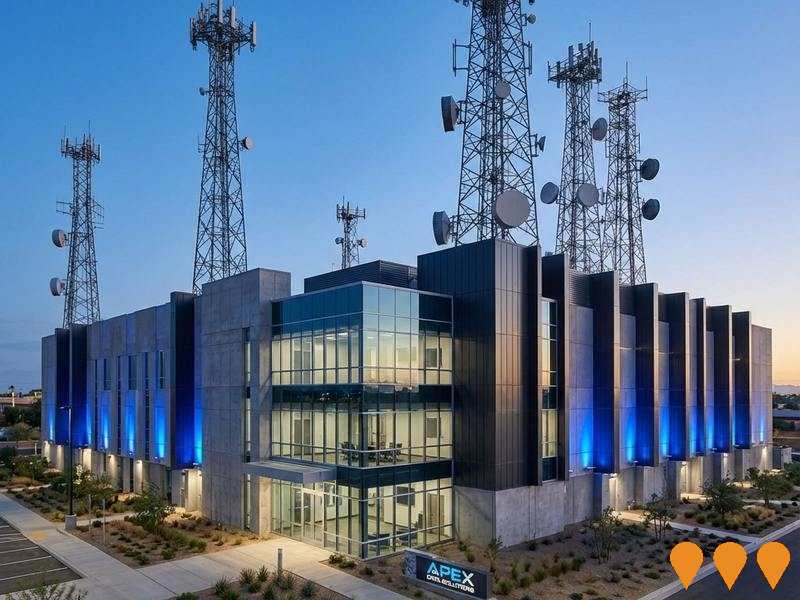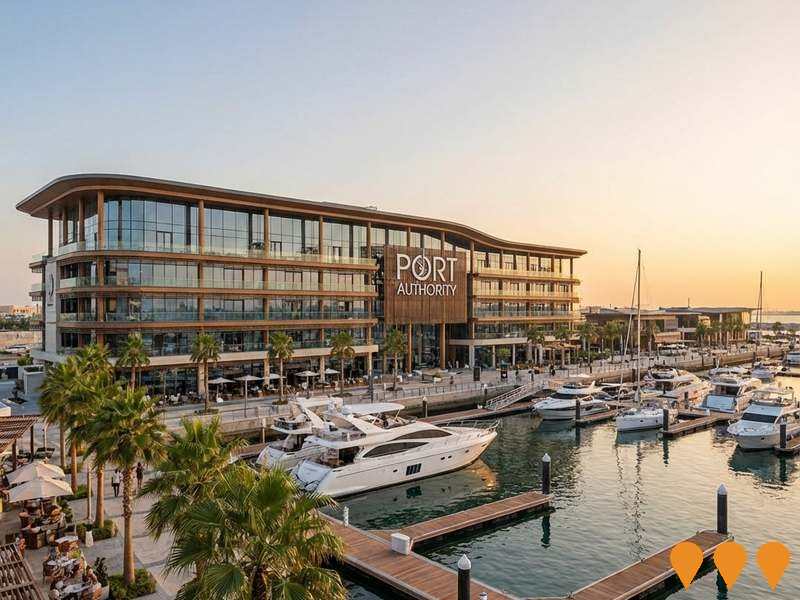Chart Color Schemes
est. as @ -- *
ABS ERP | -- people | --
2021 Census | -- people
Sales Activity
Curious about local property values? Filter the chart to assess the volume and appreciation (including resales) trends and regional comparisons, or scroll to the map below view this information at an individual property level.
Find a Recent Sale
Sales Detail
Population
Portarlington lies within the top 10% of areas nationally in terms of population growth performance according to AreaSearch analysis of short and medium-term trends
Portarlington's population is around 11,064 as of Aug 2025. This reflects an increase of 1,528 people since the 2021 Census, which reported a population of 9,536. The change was inferred from ABS estimated resident population of 10,630 in June 2024 and an additional 587 validated new addresses since the Census date. This level of population equates to a density ratio of 154 persons per square kilometer. Portarlington's growth rate of 16.0% since the 2021 census exceeded both the non-metro area average (5.5%) and national average, marking it as a growth leader in the region. Population growth was primarily driven by interstate migration contributing approximately 94.7% of overall population gains during recent periods.
AreaSearch is adopting ABS/Geoscience Australia projections for each SA2 area released in 2024 with 2022 as the base year, and VIC State Government's Regional/LGA projections released in 2023 adjusted employing a method of weighted aggregation for areas not covered by ABS data. Growth rates by age group are applied across all areas for years 2032 to 2041. Future population trends predict exceptional growth placing Portarlington in the top 10 percent of national non-metropolitan areas, with an expected expansion of 5,590 persons to 2041 based on latest population numbers, reflecting a total increase of 46.6% over the 17 years.
Frequently Asked Questions - Population
Development
The level of residential development activity in Portarlington was found to be higher than 90% of real estate markets across the country
Portarlington has averaged approximately 282 new dwelling approvals annually. Over the past five financial years, from FY-21 to FY-25, a total of 1,413 homes were approved, with an additional 26 approved so far in FY-26. Each year, on average, 1.6 new residents have arrived per new home over these five years, indicating balanced supply and demand and stable market conditions.
The average value for new dwellings developed is $559,000, which is higher than regional norms due to quality-focused development. This financial year has seen $18.5 million in commercial approvals registered, demonstrating steady commercial investment activity. Compared to the Rest of Vic., Portarlington records 75.0% more construction activity per person, providing buyers with ample choice despite a recent slowdown in building activity. This high level of construction activity is significantly higher than the national average, indicating strong developer confidence in the location. Recent construction comprises 75.0% detached houses and 25.0% attached dwellings, preserving the area's low density nature while attracting space-seeking buyers. This shift from the existing housing composition (currently 92.0% houses) suggests decreasing availability of developable sites and reflects changing lifestyles and demand for more diverse, affordable housing options.
With approximately 56 people per approval, Portarlington reflects a developing area. Looking ahead, Portarlington is projected to grow by 5,156 residents by 2041. Based on current development patterns, new housing supply should readily meet demand, offering good conditions for buyers and potentially facilitating further population growth beyond current projections.
Frequently Asked Questions - Development
Infrastructure
Portarlington has strong levels of nearby infrastructure activity, ranking in the top 40% nationally
Changes to local infrastructure significantly influence an area's performance. AreaSearch has identified 13 projects that could impact the area. Notable ones include Lifestyle St Leonards, Vista Portarlington Residences, Panorama Portarlington, and the Portarlington Recreation Reserve Master Plan. The following list details those most likely to be relevant.
Professional plan users can use the search below to filter and access additional projects.
INFRASTRUCTURE SEARCH
 Denotes AI-based impression for illustrative purposes only, not to be taken as definitive under any circumstances. Please follow links and conduct other investigations from the project's source for actual imagery. Developers and project owners wishing us to use original imagery please Contact Us and we will do so.
Denotes AI-based impression for illustrative purposes only, not to be taken as definitive under any circumstances. Please follow links and conduct other investigations from the project's source for actual imagery. Developers and project owners wishing us to use original imagery please Contact Us and we will do so.
Frequently Asked Questions - Infrastructure
Lifestyle St Leonards
Over-50s retirement community with homes, resort-style facilities including a clubhouse, and proximity to beaches and local amenities in a tranquil coastal setting. The clubhouse is complete and open. As of March 2024, the first 12 homes at The Shores are almost complete with another 13 under construction. Civil works are ongoing.

Seaside Estate
Seaside Estate is a 230-lot residential development in St Leonards on the Bellarine Peninsula. The estate offers a relaxed lifestyle and is located near beaches, wineries, and other towns. All works for the estate were complete and authority audits were undertaken as of May 2023. As of October 2022, Stages 1 through 3 were completed and Stage 8 was for sale. The estate features a Banjo Shark (Fiddler Ray) sculpture and furniture, as well as re-established vegetation to provide habitat for indigenous fauna.

Portarlington Pier Upgrade
Major upgrade to Portarlington Pier completed in 2022, featuring a 120-meter covered walkway with original artwork by 105 Wadawurrung artists celebrating Country through stories of place, water and journey. The $10 million project delivered a new strengthened pier head enabling vehicle access for the aquaculture industry and emergency response, an accessible low landing for improved water access, and a 125-meter rock groyne to protect the ferry berth and reduce erosion. The upgrade supports the Port Phillip Ferries service connecting Portarlington to Melbourne Docklands and serves commercial fishing operations and recreational users.

St Leonards-Indented Head CFA Fire Station
A new, state-of-the-art fire station that replaces the 40-year-old facility on Dudley Parade. The new station features three engine bays, a large multi-purpose room for training, a workshop, improved amenities, and sustainable features like solar panels and rainwater harvesting.

St Leonards Memorial Hall Upgrade
The upgrade of the St Leonards Memorial Hall included replacing the main flooring and repairing the sub-floor structure. External works were also completed, adding a new accessible car park, concrete to the entrance and rear courtyard, and a shade sail. The project, supported by the Victorian government and the Tiny Towns Fund, has made the hall a safer and more versatile space for community activities and events.

Portarlington Recreation Reserve Master Plan
A comprehensive master plan for the 38-hectare Portarlington Recreation Reserve providing strategic direction for sports and community facility upgrades. The plan includes pavilion refurbishment with gender-neutral change rooms, car park and entrance upgrades, cricket practice facility improvements, netball and tennis court renovations, enhanced pedestrian pathways, community gardens, and biodiversity enhancements. Currently delivering key projects via $3.75 million in state and federal funding, with State Government contributing $3.15 million and Federal Government providing $600,000. First stage completed in July 2024 with new electronic scoreboards. Pavilion change room upgrade and car park works are progressing, with designs completed and construction underway or planned for 2024-2025.

Drysdale Sporting Precinct Stage 2
Stage 2 expansion of the 32.5 hectare Drysdale Sporting Precinct includes three rectangular playing fields with competition lighting, a new multi-use pavilion with female-friendly change facilities and social spaces, two netball courts (expandable to four), play spaces, cricket training nets, a learn-to-ride cycle track, a 2.5km perimeter running track, and enhanced car parking and pathways. The precinct serves local sporting clubs including Drysdale Hawks Football Club, Drysdale Cricket Club, Drysdale Soccer Club, and Drysdale Netball Club. A separate North Bellarine Aquatic Centre with 50-metre pool opened at the precinct in 2024.

St Leonards Boat Ramp Upgrade
Stage 1 of the St Leonards boat ramp upgrade involves rebuilding the jetty, doubling the T-section, and installing wave screens for protection against wind and waves. The project also includes a new non-slip deck, solar lighting, fenders, and an accessible gangway and lower landing. A second stage, which will include additional ramp lanes and a new pedestrian path, is in the detailed design and approvals phase.

Employment
AreaSearch assessment indicates Portarlington faces employment challenges relative to the majority of Australian markets
Portarlington has a skilled workforce with well-represented essential services sectors. As of June 2025, the unemployment rate is 5.6%, with an estimated employment growth of 1.7% over the past year.
There are 4,221 residents in work, and the unemployment rate is 1.8% higher than Rest of Vic.'s rate of 3.8%. Workforce participation lags at 42.8%, compared to Rest of Vic.'s 57.4%. Leading employment industries include health care & social assistance, construction, and retail trade. Construction has a particularly high share of employment, at 1.3 times the regional level.
Agriculture, forestry & fishing employs just 2.5% of local workers, below Rest of Vic.'s 7.5%. Over the year to June 2025, employment increased by 1.7%, while labour force increased by 2.3%, resulting in a rise in unemployment rate by 0.6 percentage points. In contrast, Rest of Vic. experienced an employment decline of 0.9% and labour force decline of 0.4%. Jobs and Skills Australia forecasts national employment growth of 6.6% over five years and 13.7% over ten years. Applying these projections to Portarlington's employment mix suggests local growth of approximately 6.7% over five years and 13.7% over ten years.
Frequently Asked Questions - Employment
Income
The area's income levels rank in the lower 15% nationally based on AreaSearch comparative data
AreaSearch's latest postcode level ATO data for financial year 2022 indicates Portarlington's median income among taxpayers is $43,485. The average income in the area was $59,648 during this period. Nationally, these figures are lower than the average. In comparison, Rest of Vic.'s median income was $48,741 with an average of $60,693. Based on Wage Price Index growth of 12.16% since financial year 2022, current estimates for Portarlington's median and average incomes would be approximately $48,773 and $66,901 respectively as of September 2025. Census 2021 income data shows household, family and personal incomes in Portarlington all fall between the 9th and 12th percentiles nationally. Income analysis reveals 26.8% of the population (2,965 individuals) fall within the $400 - $799 income range, unlike trends in the region where 30.3% fall within the $1,500 - $2,999 range. After housing expenses, 85.6% of income remains, ranking at only the 12th percentile nationally. The area's SEIFA income ranking places it in the 4th decile.
Frequently Asked Questions - Income
Housing
Portarlington is characterized by a predominantly suburban housing profile, with above-average rates of outright home ownership
In Portarlington, as per the latest Census evaluation, 92.5% of dwellings were houses with 7.5% being other types such as semi-detached homes, apartments, and others. This is slightly lower than Non-Metro Vic.'s 93.0% houses and 7.0% other dwellings. Home ownership in Portarlington stood at 54.7%, with mortgaged properties at 23.5% and rented ones at 21.8%. The median monthly mortgage repayment was $1,667, below Non-Metro Vic.'s average of $1,950. Weekly rent in Portarlington was recorded at $340, compared to Non-Metro Vic.'s $402 and the national average of $375. Nationally, mortgage repayments were significantly lower than the Australian average of $1,863.
Frequently Asked Questions - Housing
Household Composition
Portarlington features high concentrations of lone person households, with a lower-than-average median household size
Family households constitute 66.7% of all households, including 16.4% couples with children, 41.6% couples without children, and 7.6% single parent families. Non-family households comprise the remaining 33.3%, with lone person households at 31.0% and group households making up 2.2% of the total. The median household size is 2.1 people, which is smaller than the Rest of Vic. average of 2.5.
Frequently Asked Questions - Households
Local Schools & Education
Portarlington shows below-average educational performance compared to national benchmarks, though pockets of achievement exist
The area's university qualification rate is 22.4%, significantly lower than Victoria's average of 33.4%. Bachelor degrees are the most common at 14.0%, followed by postgraduate qualifications (5.0%) and graduate diplomas (3.4%). Vocational credentials are prevalent, with 39.9% of residents aged 15+ holding them, including advanced diplomas (13.4%) and certificates (26.5%). A total of 21.5% of the population is currently engaged in formal education, comprising 7.5% in primary, 6.2% in secondary, and 2.8% in tertiary education.
Portarlington Primary School and St Leonards Primary School serve a combined total of 337 students, with typical Australian school conditions (ICSEA: 990) indicating balanced educational opportunities. Both schools cater exclusively to primary education, with secondary options available nearby. The area has limited local school capacity, with only 3.0 places per 100 residents compared to the regional average of 12.3, resulting in many families travelling for schooling.
Frequently Asked Questions - Education
Schools Detail
Nearby Services & Amenities
Transport
Transport servicing is low compared to other areas nationally based on assessment of service frequency, route connectivity and accessibility
Portarlington has 91 active public transport stops. These are served by buses only, with a total of 323 weekly passenger trips. Residents have good access to these stops, typically living within 278 meters of the nearest one.
Buses run on average 46 times per day across all routes, which equals about three weekly trips per stop.
Frequently Asked Questions - Transport
Transport Stops Detail
Health
Health performance in Portarlington is a key challenge with a range of health conditions having marked impacts on both younger and older age cohorts
Portarlington faces significant health challenges, with various conditions affecting both younger and older residents. Private health cover is relatively low at approximately 50%, covering around 5,476 people, compared to 56.2% across the rest of Victoria and a national average of 55.3%. The most prevalent medical conditions are arthritis (13.0%) and mental health issues (9.1%).
However, 56.4% of residents report no medical ailments, lower than the 66.8% in the rest of Victoria. The area has a higher proportion of seniors aged 65 and over at 40.4%, equating to 4,468 people, compared to 24.2% in the rest of Victoria. Despite this, health outcomes among seniors are strong and better than those of the general population.
Frequently Asked Questions - Health
Cultural Diversity
Portarlington ranks below the Australian average when compared to other local markets across a number of language and cultural background related metrics
Portarlington had a lower-than-average cultural diversity, with 82.2% of its population born in Australia, 89.8% being citizens, and 92.6% speaking English only at home. Christianity was the predominant religion, making up 54.5% of Portarlington's population compared to 45.3% across the rest of Victoria. The top three ancestry groups were English (31.1%), Australian (25.5%), and Irish (11.1%).
Notably, Maltese (2.4%) and Scottish (9.5%) were overrepresented in Portarlington compared to regional averages of 0.9% and 9.7%, respectively.
Frequently Asked Questions - Diversity
Age
Portarlington ranks among the oldest 10% of areas nationwide
Portarlington has a median age of 59, which is significantly higher than the Rest of Vic figure of 43 and the Australian median of 38. Compared to Rest of Vic., Portarlington has a higher concentration of 65-74 residents at 25.0%, but fewer 5-14 year-olds at 6.8%. This 65-74 concentration is well above the national figure of 9.4%. According to post-2021 Census data, the 65 to 74 age group has grown from 23.6% to 25.0% of Portarlington's population. Conversely, the 45 to 54 cohort has declined from 11.6% to 9.7%, and the 55 to 64 group has dropped from 18.5% to 17.4%. Looking ahead to 2041, demographic projections show significant shifts in Portarlington's age structure, with the 65 to 74 cohort projected to grow by 38%, adding 1,056 residents to reach a total of 3,821.




